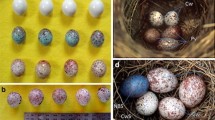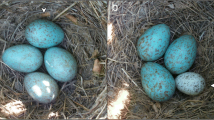Abstract
Obligate brood parasitism is associated with huge reproduction costs, forcing hosts to evolve various anti-parasitic strategies against brood parasites, among which egg recognition and rejection is the most effective defense strategy. According to the crypsis hypothesis, non-mimetic yet cryptic eggs in a nest can also deceive their hosts and eventually be accepted. To validate this hypothesis, we conducted field experiments on Oriental reed warblers (Acrocephalus orientalis), a common host for common cuckoos (Cuculus canorus). We firstly tested the egg recognition and rejection abilities of Oriental reed warblers, using black and white model eggs in natural nests. Then we designed a comparison test where the cryptic effects of the two groups of experimental eggs were different. We manipulated the nest lining color and added relatively cryptic and bright model eggs to test warblers’ rejection behaviors against cryptic and bright foreign eggs. The results showed that warblers have strong egg recognition and rejection abilities. There is a significant tendency for warblers to prefer to peck and reject relatively distinguishable foreign eggs, which supports the crypsis hypothesis. These findings indicate that even in the host-parasite system of open nests, parasitic eggs that are cryptic enough are prevented from being discovered and rejected by the host, and thus obtain the possibility of successful parasitism.



Similar content being viewed by others
References
Aidala Z, Croston R, Schwartz J, Tong L, Hauber ME (2015) The role of egg-nest contrast in the rejection of brood parasitic eggs. J Expe Biol 218:1126–1136
Aidala Z, Strausberger BM, Hauber ME (2019) Increased egg-nest visual contrast does not induce egg ejection in the eastern phoebe (Sayornis phoebe), an accepter host of the brood parasitic brown-headed cowbird (Molothrus ater). J Comp Psych 133:46–55
Antonov A, Stokke BG, Moksnes A, Røskaft E (2007) First evidence of regular common cuckoo, Cuculus canorus, parasitism on eastern olivaceous warblers, Hippolais pallidaelaeica. Naturwissenschaften 94:307–312
Avilés JM, Soler JJ, Soler M, Møller AP (2004) Rejection of parasitic eggs in relation to egg appearance in magpies. Anim Behav 67:951–958
Avilés JM, Stokke BG, Moksnes A, Røskaft E, Møller ÅM (2006) Rapid increase in cuckoo egg matching in a recently parasitized Reed Warbler population. J Evol Biol 19:1901–1910
Avilés JM, Martín-Gálvez D, De Neve L, Soler M, Soler JJ (2015) Ambient light in domed nests and discrimination of foreign egg colours. Behav Ecol Sociobiol 69:425–435
Bennett ATD, Cuthill IC, Partridge JC, Maier EJ (1996) Ultraviolet vision and mate choice in zebra finches. Nature 380:433–435
Cherry MI, Bennett ATD, Moskát C (2007) Do cuckoos choose nests of great reed warblers on the basis of host egg appearance? J Evol Biol 20:1218–1222
Cuthill IC, Partridge JC, Bennett ATD, Church SC, Hart NS, Hunt S (2000) Ultraviolet vision in birds. Advan in Study Behav 29:159–214
Davies NB (2000) Cuckoos, cowbirds and other cheats. T. & A. D. Poyser, London
Davies NB (2011) Cuckoo adaptations: trickery and tuning. J Zool 284:1–14
Davies NB, Brooke MDL (1989) An experimental study of co-evolution between the cuckoo, Cuculus canorus, and its hosts. I. Host egg discrimination. J Anim Ecol 58:207–224
Davies NB, Kilner RM, Noble DG (1998) Nestling cuckoos, Cuculus canorus, exploit hosts with begging calls that mimic a brood. Proc Roy Soc B Biol Sci 265:673–678
Feeney WE, Welbergen JA, Langmore NE (2014) Advances in the study of coevolution between avian brood parasites and their hosts. Annu Rev Ecol Evol Sys 45:227–246
Gloag R, Keller LA, Langmore NE (2014) Cryptic cuckoo eggs hide from competing cuckoos. Proc Roy Soc B Biol Sci 281:20141014
Hauber ME, Aidala Z, Igic B, Shawkey MD, Moskát C (2015) Experimental shifts in egg-nest contrasts do not alter egg rejection responses in an avian host-brood parasite system. Anim Cogn 18:1133–1141
Honza M, Šulc M, Jelínek V, Požgayová M, Procházka P (2014) Brood parasites lay eggs matching the appearance of host clutches. Proc Roy Soc B Biol Sci 281:20132665
Honza M, Požgayová M, Procházka P, Koleček J (2020) Errors in egg-laying by female common Cuckoo Cuculus canorus in nests of its common host. Ibis 162:637–644
Huo J, Su T, Niu N, Yang C, Liang W (2018) Last but not the least: effects of laying sequence on egg colour variation and embryonic development of russet sparrow (Passer cinnamomeus). Avian Res 9:21
Kilner RM (2003) How selfish is a cowbird nestling? Anim Behav 66:569–576
Kilner RM (2006) The evolution of egg colour and patterning in birds. Biolo Rev 81:383–406
Langmore NE, Stevens M, Maurer G, Kilner RM (2009) Are dark cuckoo eggs cryptic in host nests? Anim Behav 78:461–468
Li D, Ruan Y, Wang Y, Chang AK, Wan D, Zhang Z (2016) Egg-spot matching in common cuckoo parasitism of the Oriental reed warbler: effects of host nest availability and egg rejection. Avian Res 7:21
Liang G, Yang C, Wang L, Liang W (2014) Variation in parasitism rates by common cuckoos among three populations of the Oriental reed warblers. Sichuan J Zool 33:673–677
Lyu N, Liang W (2021) Parasitism is always costly to the host. Zool Res 42:217–220
McCormick-Goodhart M, Wilhelm H (2003) A new test method based on CIELAB Colourimetry for evaluating the permanence of pictorial images. Wilhelm Imaging Res. http://www.wilhelm-research.com/articles-wir-additional.html
Medina I, Langmore NE (2019) Nest illumination and the evolution of egg rejection in hosts of brood parasites. Auk 136:1–6
Moksnes A, Røskaft E, Braa AT, Korsnes L, Lampe HM, Pedersen HC (1991) Behavioural responses of potential hosts towards artificial cuckoo eggs and dummies. Behaviour 116:64–89
Moksnes A, Fossø F, Røskaft E, Stokke BG (2013) Reviewing 30 years of studies on the common cuckoo: accumulated knowledge and future perspectives. Chin Birds 4:3–14
Moskát C (2005) Nest defence and egg rejection in great reed warblers over the breeding cycle: are they synchronised with the risk of brood parasitism? Ann Zool Fenn 42:579–586
Peer BD, Sealy SG (2004) Fate of grackle (Quiscalus spp.) defenses in the absence of brood parasitism: implications for long-term parasite-host coevolution. Auk 121:1172–1186
Rajchard J (2009) Ultraviolet (UV) light perception by birds: a review. Vet Med 54:351–359
Robertson AR (2007) Colourimetry-Part 4: CIE 1976 L*a*b* colour space. CIE DS014-4.3/E. CIE Central Bureau, Vienna
Røskaft E, Moksnes A, Stokke BG, Bicík V, Moskát C (2002) Aggression to dummy cuckoos by potential European cuckoo hosts. Behaviour 139:613–628
Rothstein SI (1990) A model system for coevolution: avian brood parasitism. Ann Rev Ecol Sys 21:481–508
Ruxton GD, Broom M, Colegrave N (2001) Are unusually coloured eggs a signal to potential conspecific brood parasites? Am Nat 157:451–458
Samaš P, Hauber ME, Cassey P, Grim T (2014) Host responses to interspecific brood parasitism: a by-product of adaptations to conspecific parasitism? Front Zool 11:34
Samaš P, Rutila J, Grim T (2016) The common redstart as a suitable model to study cuckoo-host coevolution in a unique ecological context. BMC Evol Biol 16:255
Samaš P, Rutila J, Honza M, Kysučan M, Grim T (2018) Rearing a virulent common cuckoo is not extra costly for its only cavity-nesting host. Proc Roy Soc B Biol Sci 285:20181710
Samaš P, Grim T, Jelínek V, Abraham MM, Šulc M, Honza M (2019) No immediate or future extra costs of raising a virulent brood parasite chick. Behav Ecol 30:1020–1029
Sealy SG, Underwood TJ (2012) Egg discrimination by hosts and obligate brood parasites: a historical perspective and new synthesis. Chin Birds 3:274–294
Soler M (2014) Long-term coevolution between avian brood parasites and their hosts. Biol Rev 89:688–704
Soler JJ, Soler M, Pérez-Contreras T, Aragón S, Møller AP (1999) Antagonistic antiparasite defenses: nest defence and egg rejection in the magpie host of the great spotted cuckoo. Behav Ecol 10:707–713
Šulc M, Procházka P, Capek M, Honza M (2016) Birds use eggshell UV reflectance when recognizing non-mimetic parasitic eggs. Behav Ecol 27:677–684
Thorogood R, Kilner R, Rasmussen JL (2017) Grey gerygone hosts are not egg rejecters, but shining bronze-cuckoos lay cryptic eggs. Auk 134:340–349
Trnka A, Požgayová M, Procházka P, Prokop P, Honza M (2012) Breeding success of a brood parasite is associated with social mating status of its host. Behav Ecol Sociobiol 66:1187–1194
Wang L, Yang C, Møller AP, Liang W, Lu X (2015) Multiple mechanisms of egg recognition in a cuckoo host. Behav Ecol Sociobiol 69:1761–1767
Wang L, Yang C, He G, Liang W, Møller AP (2020a) Cuckoos use host egg number to choose host nests for parasitism. Proc Roy Soc B Biol Sci 287:20200343
Wang L, Zhong G, He G, Zhang Y, Liang W (2020b) Egg laying behavior of common cuckoos (Cuculus canorus): Data based on field video-recordings. Zool Res 41:458–464
Wang L, Zhang Y, Liang W, Møller AP (2021) Common cuckoo females remove more conspicuous eggs during parasitism. Roy Soc Open Sci 8:201264
Xiao F, Yang C, Shi H, Wang J, Sun L, Lin L (2016) Background matching and camouflage efficiency predict population density in four-eyed turtle (Sacalia quadriocellata). Behav Proc 131:40–46
Yang C, Liang W, Antonov A, Cai Y, Stokke BG, Fossøy F, Moksnes A, Røskaft E (2012) Diversity of parasitic cuckoos and their hosts in China. Chin Birds 3:9–32
Yang C, Li D, Wang L, Liang G, Zhang Z, Liang W (2014) Geographic variation in parasitism rates of two sympatric cuckoo hosts in China. Zool Res 35:67–71
Yang C, Huang Q, Wang L, Jiang A, Stokke BG, Fossøy F, Møller AP (2016a) Plaintive cuckoos do not select tailorbird hosts that match the phenotypes of their own eggs. Behav Ecol 27:835–841
Yang C, Wang L, Liang W, Møller AP (2016b) Do common cuckoos (Cuculus canorus) possess an optimal laying behaviour to match their own egg phenotype to that of their Oriental reed warbler (Acrocephalus orientalis) hosts? Biol J Linn Soc 117:422–427
Yang C, Wang L, Liang W, Møller AP (2019) High egg rejection rate in a Chinese population of grey-backed thrush (Turdus hortulorum). Zool Res 40:226–230
Acknowledgements
We are grateful to Wenfeng Wang from Zhalong National Nature Reserve for the help and cooperation.
Funding
This work was supported by the National Natural Science Foundation of China (Nos. 31960105 to LW, 31772453 and 31970427 to WL). LW was funded by the Joint Fund of the National Natural Science Foundation of China and the Karst Science Research Center of Guizhou province (No. U1812401).
Author information
Authors and Affiliations
Contributions
W.L. designed the study; L.W., J.M. and Y.Z. carried out field experiments; L.W. performed statistical analyses and wrote the draft manuscript; W.L. improved the manuscript. All authors approved the final submission.
Corresponding author
Ethics declarations
Conflict of interest
We declare that we have no competing interests.
Ethical standards
The experiments comply with the current laws of China, where they were performed. Fieldwork was carried out with permission (no. ZL-GZNU-2019-06) from Zhalong National Nature Reserve, Heilongjiang, China. Experimental procedures were in agreement with the Animal Research Ethics Committee of Hainan Provincial Education Centre for Ecology and Environment, Hainan Normal University (no. HNECEE-2012-003).
Additional information
Publisher's Note
Springer Nature remains neutral with regard to jurisdictional claims in published maps and institutional affiliations.
Supplementary Information
Below is the link to the electronic supplementary material.
Rights and permissions
About this article
Cite this article
Wang, L., He, G., Zhang, Y. et al. Cryptic eggs are rejected less frequently by a cuckoo host. Anim Cogn 24, 1171–1177 (2021). https://doi.org/10.1007/s10071-021-01507-2
Received:
Revised:
Accepted:
Published:
Issue Date:
DOI: https://doi.org/10.1007/s10071-021-01507-2




